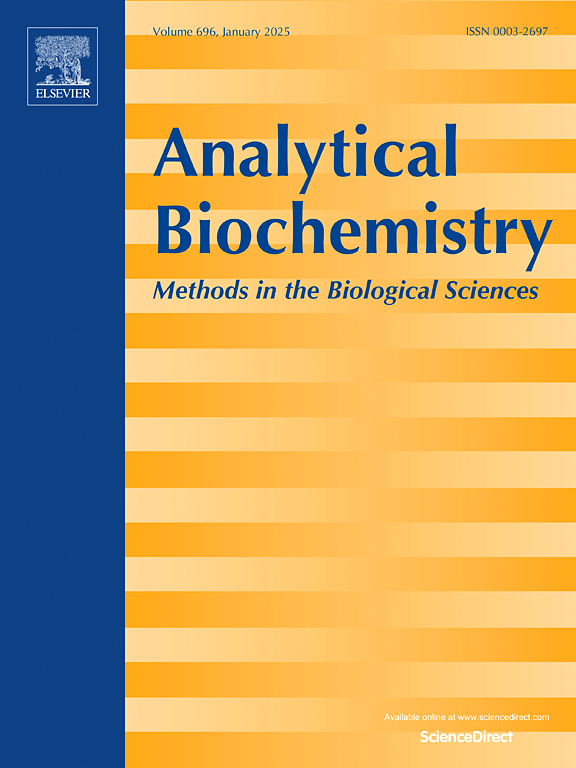A site-specific fluorogenic probe for protein disulfide isomerase A1
IF 2.5
4区 生物学
Q2 BIOCHEMICAL RESEARCH METHODS
引用次数: 0
Abstract
Background
Protein disulfide isomerase A1 (PDIA1) is essential for catalyzing disulfide bond isomerization, ensuring proper protein folding, and maintaining cellular homeostasis. Dysregulation of PDIA1 function is implicated in various diseases, emphasizing the need for tools to study its activity dynamically and specifically. Despite this need, current methods lack the sensitivity and robustness required for reliable detection of PDIA1 activity.(57)
Results
We synthesized a series of vinyl sulfone-based fluorescent probes capable of covalently binding to thiol groups, triggering fluorescence activation. Among these, the probe LS exhibited outstanding performance, achieving a ∼18-fold fluorescence intensity increase upon binding to PDIA1. LS showed high specificity for PDIA1 by selectively targeting the cysteine residue at position 397 in its active site. The probe demonstrated rapid fluorescence activation with significant intensity enhancement within a short time. Furthermore, LS featured consistent excitation and emission wavelengths, making it ideal for fluorescence-based detection. (84)
Significance
The strong targeting ability, rapid response, and stability of LS provide a powerful platform for real-time, dynamic monitoring of PDIA1 activity. This probe holds significant promise for exploring PDIA1's roles in physiological and pathological processes and advancing research in PDIA1-associated diseases using vinyl sulfone-based fluorescent probes.(46)

蛋白二硫异构酶A1的位点特异性荧光探针
蛋白质二硫异构酶A1 (PDIA1)是催化二硫键异构化,确保适当的蛋白质折叠和维持细胞内稳态所必需的。PDIA1功能失调与多种疾病有关,强调需要动态和特异性研究其活性的工具。尽管存在这种需求,但目前的方法缺乏可靠检测PDIA1活性所需的灵敏度和鲁棒性。(57)结果我们合成了一系列基于乙烯基砜的荧光探针,能够与巯基共价结合,触发荧光激活。其中,探针LS表现出优异的性能,与PDIA1结合后荧光强度增加了~ 18倍。LS选择性靶向PDIA1活性位点397位半胱氨酸残基,对PDIA1具有高特异性。探针表现出快速的荧光激活,在短时间内强度显著增强。此外,LS具有一致的激发和发射波长,使其成为基于荧光的检测的理想选择。(84)意义LS的强靶向能力、快速反应和稳定性为实时、动态监测PDIA1活性提供了强大的平台。该探针对于探索PDIA1在生理和病理过程中的作用以及使用基于乙烯基砜的荧光探针推进PDIA1相关疾病的研究具有重要的前景(46)。
本文章由计算机程序翻译,如有差异,请以英文原文为准。
求助全文
约1分钟内获得全文
求助全文
来源期刊

Analytical biochemistry
生物-分析化学
CiteScore
5.70
自引率
0.00%
发文量
283
审稿时长
44 days
期刊介绍:
The journal''s title Analytical Biochemistry: Methods in the Biological Sciences declares its broad scope: methods for the basic biological sciences that include biochemistry, molecular genetics, cell biology, proteomics, immunology, bioinformatics and wherever the frontiers of research take the field.
The emphasis is on methods from the strictly analytical to the more preparative that would include novel approaches to protein purification as well as improvements in cell and organ culture. The actual techniques are equally inclusive ranging from aptamers to zymology.
The journal has been particularly active in:
-Analytical techniques for biological molecules-
Aptamer selection and utilization-
Biosensors-
Chromatography-
Cloning, sequencing and mutagenesis-
Electrochemical methods-
Electrophoresis-
Enzyme characterization methods-
Immunological approaches-
Mass spectrometry of proteins and nucleic acids-
Metabolomics-
Nano level techniques-
Optical spectroscopy in all its forms.
The journal is reluctant to include most drug and strictly clinical studies as there are more suitable publication platforms for these types of papers.
 求助内容:
求助内容: 应助结果提醒方式:
应助结果提醒方式:


